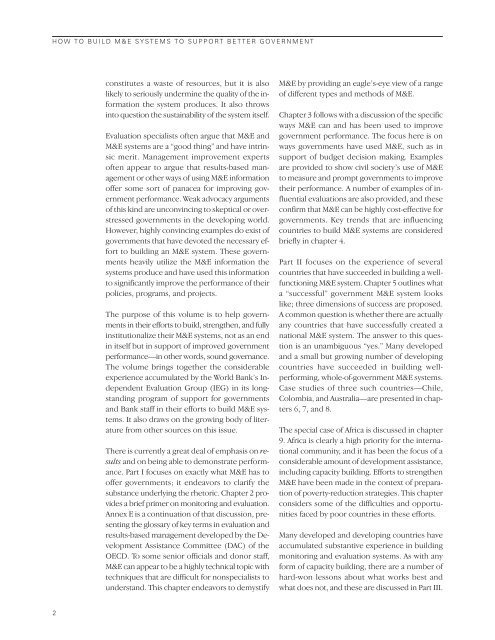How to Build M&E Systems to Support Better Government How to ...
How to Build M&E Systems to Support Better Government How to ...
How to Build M&E Systems to Support Better Government How to ...
You also want an ePaper? Increase the reach of your titles
YUMPU automatically turns print PDFs into web optimized ePapers that Google loves.
HOW TO BUILD M&E SYSTEMS TO SUPPORT BETTER GOVERNMENT<br />
constitutes a waste of resources, but it is also<br />
likely <strong>to</strong> seriously undermine the quality of the information<br />
the system produces. It also throws<br />
in<strong>to</strong> question the sustainability of the system itself.<br />
Evaluation specialists often argue that M&E and<br />
M&E systems are a “good thing” and have intrinsic<br />
merit. Management improvement experts<br />
often appear <strong>to</strong> argue that results-based management<br />
or other ways of using M&E information<br />
offer some sort of panacea for improving government<br />
performance. Weak advocacy arguments<br />
of this kind are unconvincing <strong>to</strong> skeptical or overstressed<br />
governments in the developing world.<br />
<strong>How</strong>ever, highly convincing examples do exist of<br />
governments that have devoted the necessary effort<br />
<strong>to</strong> building an M&E system. These governments<br />
heavily utilize the M&E information the<br />
systems produce and have used this information<br />
<strong>to</strong> significantly improve the performance of their<br />
policies, programs, and projects.<br />
The purpose of this volume is <strong>to</strong> help governments<br />
in their efforts <strong>to</strong> build, strengthen, and fully<br />
institutionalize their M&E systems, not as an end<br />
in itself but in support of improved government<br />
performance—in other words, sound governance.<br />
The volume brings <strong>to</strong>gether the considerable<br />
experience accumulated by the World Bank’s Independent<br />
Evaluation Group (IEG) in its longstanding<br />
program of support for governments<br />
and Bank staff in their efforts <strong>to</strong> build M&E systems.<br />
It also draws on the growing body of literature<br />
from other sources on this issue.<br />
There is currently a great deal of emphasis on results<br />
and on being able <strong>to</strong> demonstrate performance.<br />
Part I focuses on exactly what M&E has <strong>to</strong><br />
offer governments; it endeavors <strong>to</strong> clarify the<br />
substance underlying the rhe<strong>to</strong>ric. Chapter 2 provides<br />
a brief primer on moni<strong>to</strong>ring and evaluation.<br />
Annex E is a continuation of that discussion, presenting<br />
the glossary of key terms in evaluation and<br />
results-based management developed by the Development<br />
Assistance Committee (DAC) of the<br />
OECD. To some senior officials and donor staff,<br />
M&E can appear <strong>to</strong> be a highly technical <strong>to</strong>pic with<br />
techniques that are difficult for nonspecialists <strong>to</strong><br />
understand. This chapter endeavors <strong>to</strong> demystify<br />
M&E by providing an eagle’s-eye view of a range<br />
of different types and methods of M&E.<br />
Chapter 3 follows with a discussion of the specific<br />
ways M&E can and has been used <strong>to</strong> improve<br />
government performance. The focus here is on<br />
ways governments have used M&E, such as in<br />
support of budget decision making. Examples<br />
are provided <strong>to</strong> show civil society’s use of M&E<br />
<strong>to</strong> measure and prompt governments <strong>to</strong> improve<br />
their performance. A number of examples of influential<br />
evaluations are also provided, and these<br />
confirm that M&E can be highly cost-effective for<br />
governments. Key trends that are influencing<br />
countries <strong>to</strong> build M&E systems are considered<br />
briefly in chapter 4.<br />
Part II focuses on the experience of several<br />
countries that have succeeded in building a wellfunctioning<br />
M&E system. Chapter 5 outlines what<br />
a “successful” government M&E system looks<br />
like; three dimensions of success are proposed.<br />
A common question is whether there are actually<br />
any countries that have successfully created a<br />
national M&E system. The answer <strong>to</strong> this question<br />
is an unambiguous “yes.” Many developed<br />
and a small but growing number of developing<br />
countries have succeeded in building wellperforming,<br />
whole-of-government M&E systems.<br />
Case studies of three such countries—Chile,<br />
Colombia, and Australia—are presented in chapters<br />
6, 7, and 8.<br />
The special case of Africa is discussed in chapter<br />
9. Africa is clearly a high priority for the international<br />
community, and it has been the focus of a<br />
considerable amount of development assistance,<br />
including capacity building. Efforts <strong>to</strong> strengthen<br />
M&E have been made in the context of preparation<br />
of poverty-reduction strategies. This chapter<br />
considers some of the difficulties and opportunities<br />
faced by poor countries in these efforts.<br />
Many developed and developing countries have<br />
accumulated substantive experience in building<br />
moni<strong>to</strong>ring and evaluation systems. As with any<br />
form of capacity building, there are a number of<br />
hard-won lessons about what works best and<br />
what does not, and these are discussed in Part III.<br />
2
















![[PDF] Community Development Toolkit - CommDev](https://img.yumpu.com/48616495/1/184x260/pdf-community-development-toolkit-commdev.jpg?quality=85)
